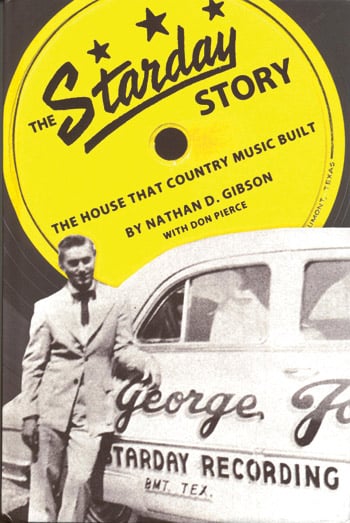The Starday Story: The House That Country Music Built
 THE STARDAY STORY: THE HOUSE THAT COUNTRY MUSIC BUILT
THE STARDAY STORY: THE HOUSE THAT COUNTRY MUSIC BUILT
BY NATHAN GIBSON WITH DON PIERCE
Univ. Press of Miss., 9781604738308. Hardback, b&w photos, record listing, bibliography, index, 265 pp. (Univ. Press of Miss., 3825 Ridgewood Rd., Jackson, MS 39211, www.upress.state.ms.us.)
If you are a long-time bluegrass fan, chances are your record shelves are populated with Starday albums—the vinyl kind. The Stanley Brothers, Carl Story, the Lewis Family, Bill Clifton, early Country Gentlemen, the Stoneman Family, and Alex and Ola Belle Reed all recorded for Starday Records. The label not only launched the careers of George Jones, Roger Miller, and Dottie West, it also revived the careers of Cowboy Copas, Red Sovine, and Moon Mullican and provided a home for older acts such as Stringbean, Clyde Moody, the Blue Sky Boys, and Wayne Raney.
As this meticulously researched work reveals, Starday was one of the most important and innovative independent labels in country music history—with the largest bluegrass catalog in the world. Starday Recording and Publishing Company was co-founded in 1953 by Jack Starnes, Pappy Daily, and Don Pierce, and author Nathan Gibson was incredibly fortunate to have Pierce on board for the writing of this book. Not only did Pierce provide access to his friends in the business, his own vivid memories flesh out what could have become a dull and boring narrative.
Gibson traces the history of Starday from its beginnings in Texas, through its move to Nashville in 1957, its sale to the Lin Broadcasting Company (which also bought King Records) in 1970, and the subsequent sale of the Starday/King catalog to Gusto where it now resides as part of Moe Lytle’s IMG cooperation. The book pays tribute to Pierce, a “country music maverick” who “tirelessly promoted country music through its darkest hours.” A bold innovator, he opened up country music’s acceptance overseas, pioneered budget labels and country music record clubs, and was among the first to record and release full-length record albums. Last but not least, the book includes an almost-complete listing of Starday and Starday-related records from 1953 to 1970, a welcome addition to the world of music research.
There is an incredible amount of information here in these 170 pages of text, and occasionally the flow bogs down a bit. Wading through the minute details of Lefty Frizzell’s tribulations with Jack Starnes right off the bat was somewhat trying, but sticking it out proved to be extremely worthwhile. Not everyone will enjoy a behind-the-scenes look at what made an independent record company successful, but if you are interested in the business end of the music business, The Starday Story will provide a fascinating read. MHH
